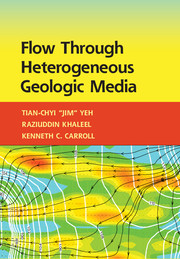Book contents
- Frontmatter
- Contents
- Preface and Acknowledgments
- 1 Fluid Statics and Dynamics
- 2 Darcy's Law for Saturated Porous Media
- 3 Darcy's Law for Unsaturated Porous Media
- 4 Stochastic Conceptualization of Heterogeneity
- 5 Governing Flow Equations for Heterogeneous Media Conceptual Models
- 6 Equivalent Homogeneous Media Conceptual Models
- 7 Flow toward a Well Due to Pumping (Part 1)
- 8 Flow toward a Well Due to Pumping (Part 2)
- 9 Stochastic Approaches
- References
- Index
2 - Darcy's Law for Saturated Porous Media
Published online by Cambridge University Press: 05 July 2015
- Frontmatter
- Contents
- Preface and Acknowledgments
- 1 Fluid Statics and Dynamics
- 2 Darcy's Law for Saturated Porous Media
- 3 Darcy's Law for Unsaturated Porous Media
- 4 Stochastic Conceptualization of Heterogeneity
- 5 Governing Flow Equations for Heterogeneous Media Conceptual Models
- 6 Equivalent Homogeneous Media Conceptual Models
- 7 Flow toward a Well Due to Pumping (Part 1)
- 8 Flow toward a Well Due to Pumping (Part 2)
- 9 Stochastic Approaches
- References
- Index
Summary
Introduction
This chapter develops and explains principles of fluid flow through porous media in terms of principles of fluid mechanics presented in Chapter 1. A porous medium or a porous material is defined as a solid (often called a matrix) permeated by an interconnected network of pores (voids) filled with a fluid (e.g., air or water). Usually both the solid matrix and the pore network (also known as the pore space) are assumed to be continuous, so as to form two interpenetrating continua (e.g., soils, rocks, or geologic formations). In this chapter, Poiseuille's law for flow through a capillary tube is first derived to understand effects of various factors on flow along a flow path in porous media. On the basis of Poiseuille's law, a mathematical model is subsequently developed for flow through a porous medium. Introduction of Darcy's law and the representative elementary volume (REV) concept then follow. Next, the mathematical model based on Poiseuille's law is compared to Darcy's law and is then used to elucidate the physical interpretation of Darcy's law and the hydraulic conductivity. Then, limitations of Darcy's law are discussed. Finally, laboratory methods for determining the hydraulic conductivity are presented.
Flow Through a Capillary Tube
Before discussing flow in porous media, let us examine flow through an idealized system. One of the simplest systems, which nonetheless has many characteristics of relevance to understanding flow in porous media, is flow through a capillary tube. In the following, we describe how a cylindrical capillary tube is used to approximate the actual flow in a porous medium.
As shown in Figure 2.1a, suppose we observe the path of a fluid particle at a microscopic level in a porous medium that is fully saturated with a fluid. As we focus on the fluid pathway (shown as a line with an arrow), we notice that the pore (void) spaces, between the solid particles through which flow occurs, are quite variable.We also notice that the flow path is quite tortuous, and the variable geometry of the flow path cannot be easily described. To avoid these complications, we will approximate the actual, tortuous (crooked) flow path through the voids or pore spaces as an idealized straight flow path through a cylindrical capillary tube of a very small diameter (see Figure 2.1b).
- Type
- Chapter
- Information
- Flow through Heterogeneous Geologic Media , pp. 32 - 68Publisher: Cambridge University PressPrint publication year: 2015
- 1
- Cited by



